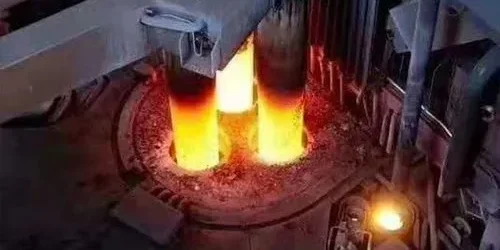
Consumption of Tanlin Carbon Electrode Paste in Calcium Carbide Furnaces
- Forms of Consumption
- Oxidative Consumption
In the high-temperature and oxidizing furnace environment, the exposed part of the Tanlin Carbon electrode reacts with oxygen, leading to material loss. Higher surface temperatures speed up oxidation, and the oxidizing atmosphere in the furnace worsens the situation. However, Tanlin Carbon’s electrode paste has good anti-oxidation properties, reducing oxidation loss and extending the electrode’s lifespan compared to ordinary pastes. - Arc Erosion Consumption
When an arc forms between the electrode and the furnace charge, high temperatures cause the electrode surface material to melt and evaporate, resulting in consumption. Unstable arcs lead to more intense local erosion. Tanlin Carbon optimizes the paste’s formula and production process to improve arc erosion resistance and reduce consumption. - Mechanical Wear Consumption
During electrode lifting and rotation, friction with components like the holder and furnace wall causes mechanical wear. The movement and impact of the furnace charge can also damage the electrode. Tanlin Carbon’s electrode paste has good mechanical strength and wear resistance. Proper operation and equipment maintenance can further reduce mechanical wear.
- Oxidative Consumption
- Factors Affecting Consumption
- Operation Process
A reasonable operation process is key to reducing consumption. Stable furnace charge ratio and charging speed maintain reaction stability and reduce arc fluctuations, thus lowering erosion consumption. Correct electrode operation and proper working length control also reduce mechanical and oxidative wear. Tanlin Carbon provides training and support to help customers optimize the process and reduce consumption. - Electrode Quality
Tanlin Carbon’s high-quality electrode paste, made from good binders and raw materials, has excellent oxidation resistance, conductivity, and mechanical strength. This significantly reduces consumption compared to other brands, offering longer lifespan and better performance. - Furnace Structure
The furnace structure affects electrode paste consumption. A reasonable design can make the temperature and gas flow more uniform, reducing local overheating and oxidation. Tanlin Carbon cooperates with furnace manufacturers to provide optimization solutions for customers, improving working conditions and reducing consumption.
- Operation Process
- Measures to Reduce Consumption
- Optimize Operation Parameters
Customers can adjust parameters like furnace charge ratio, charging speed, and electrode current to stabilize furnace conditions and reduce abnormal electrode consumption. Regular electrode inspection and maintenance, along with timely adjustment of the working length, ensure normal operation. Tanlin Carbon’s experts offer personalized parameter optimization plans based on customers’ production situations. - Choose High-quality Electrode Paste
Selecting Tanlin Carbon’s high-quality electrode paste is the most fundamental way to reduce consumption. With various types and specifications available, customers can choose the most suitable product for their furnace. Tanlin Carbon keeps innovating and upgrading products to meet different needs. - Improve Furnace Structure
Optimizing the furnace structure, such as using new cooling technologies and better electrode holder designs, can improve the working environment and reduce electrode consumption. Tanlin Carbon provides comprehensive solutions from design to after-sales service to help customers upgrade their furnaces and achieve better production efficiency.
- Optimize Operation Parameters
In conclusion, understanding the roasting and consumption of Tanlin Carbon electrode paste in calcium carbide furnaces and taking appropriate measures can help customers make the most of its performance, improve electrode quality and lifespan, cut costs, and achieve sustainable and efficient production.
